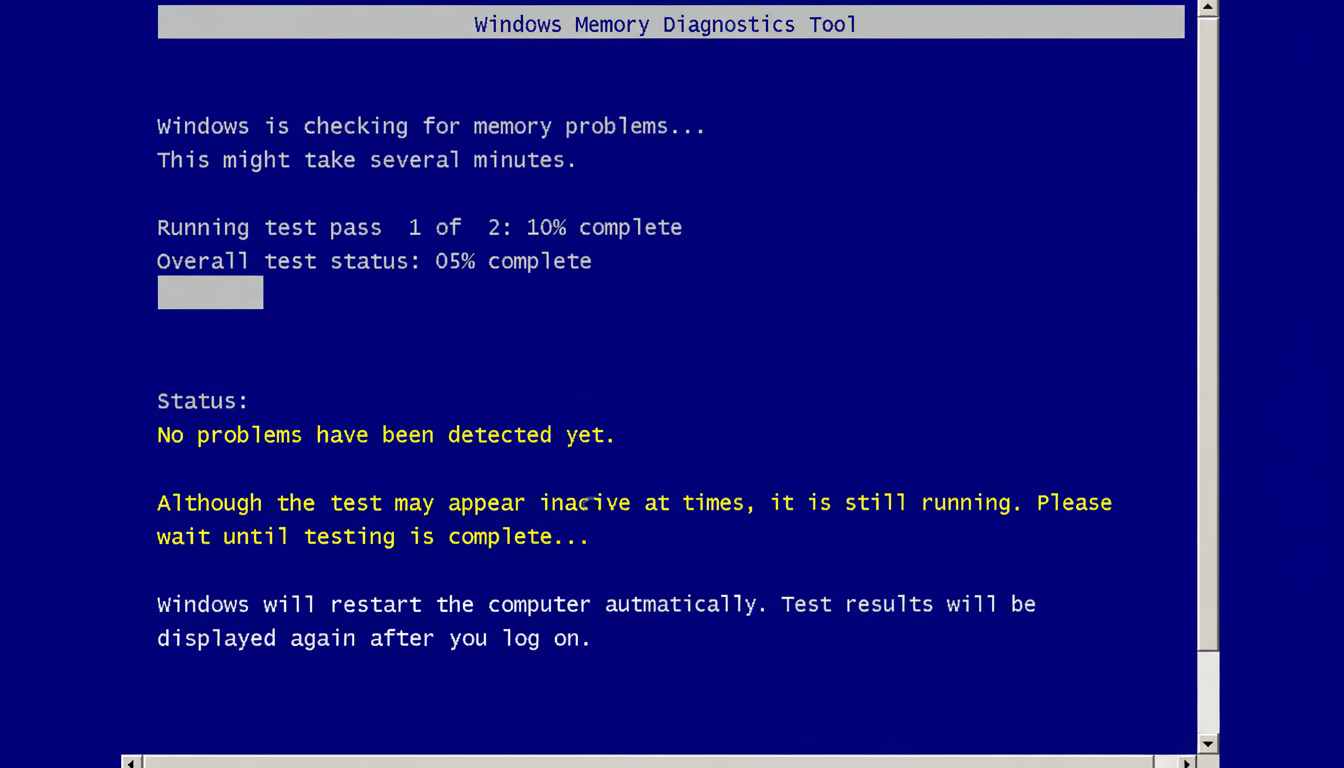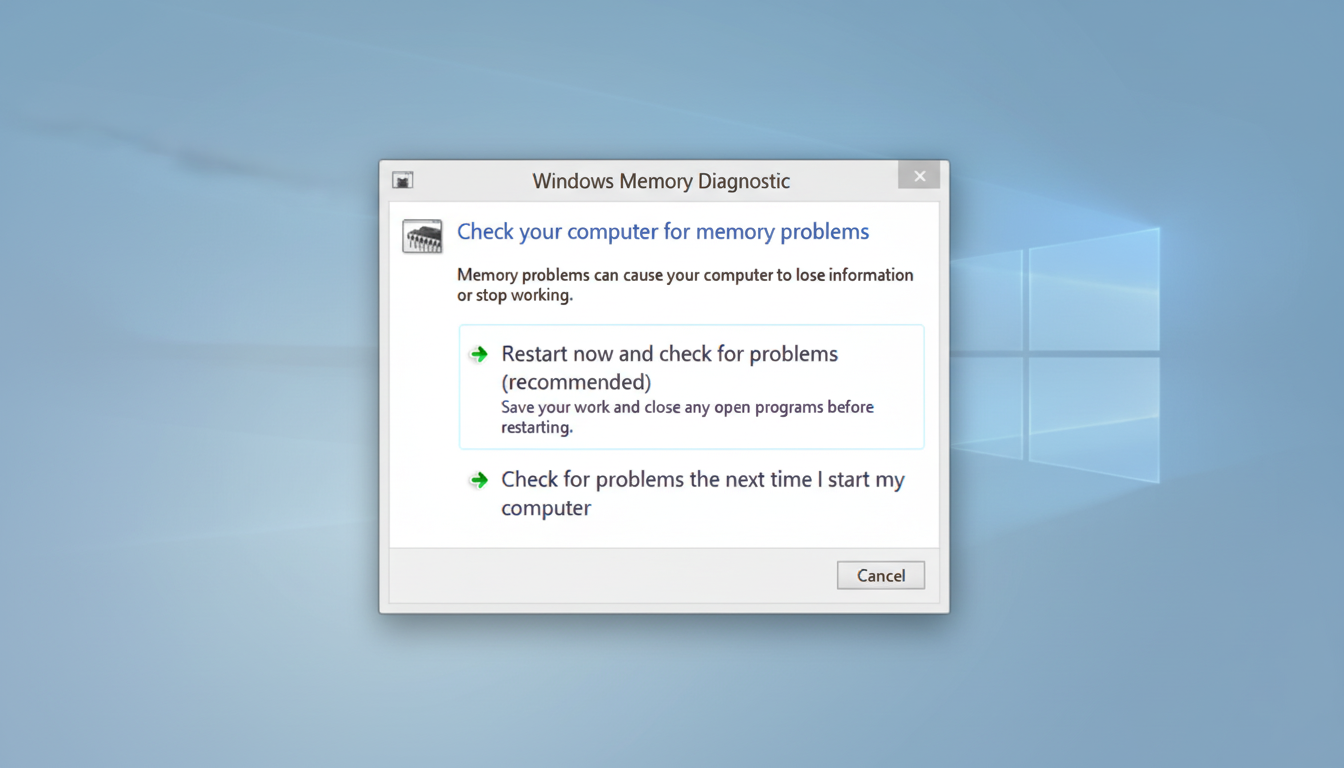Microsoft is working on a helpful recovery assist for Windows 11: the OS will alert you to run a quick memory test after suffering a Blue Screen of Death during the next reboot. The aim is simple: catch RAM issues before they become a full-system problem and turn an otherwise enigmatic crash into an identifiable issue, and do so without requiring users to trawl through error codes from developer apps or download third-party utilities.
How The Post-Crash Memory Scan Is Offered
If it crashes and restarts suddenly, Windows 11 will present a sign-in notification asking if you would like to schedule a Windows Memory Diagnostic to run the next time you boot. It’s opt-in, not automatic, so you can disregard it if you’re sure that the crash was a one-time driver gaffe. If you agree, the test runs before Windows is loaded, in an average of five minutes, and then boots you right back to the desktop.

If the check does find a problem—say, an unstable DIMM or bad memory channel—Windows will issue you a notification after reboot. That visibility is crucial: memory faults can look like application crashes, corrupt files, or intermittent BSODs that you struggle to reproduce. One generation went from “turn it off and back on again” to “possibly replace something;” another reduced the process of identifying a problem from 10 minutes to half a second.
Who gets it first: Windows Insiders and initial rollout
The feature is beginning to roll out for testing today to Windows Insiders, as part of Windows 11 Insider Preview Build 26220.6982 (KB5067109). Early release allows Microsoft to see edge cases and reliability before releasing it more widely to the general Windows 11 population in a future update.
There have been caveats issued during trial.
The prompt isn’t yet enabled on Windows on ARM, and it may be muted when certain security policies are in place—like Administrator Protection or BitLocker deployments that take place without Secure Boot. Microsoft frequently rolls out features in stages to its Insider cohorts, so not all participants will immediately see the prompt.
Why memory scans are important for BSODs and stability
Anyone who’s ever chased down BSODs knows that memory errors are one of the common suspects, just behind drives and/or drivers. Even Microsoft help directives often direct users to memory tests when crashes have no clear cause. Putting the prompt right up after a crash removes friction: no need for learning command-line switches or boot keys, and no temptation to install dubious tools.
There’s also good reason to believe that memory faults are far more common than most users realize. A seminal Google work on DRAM reliability discovered a large fraction of DIMMs in production systems with correctable errors per year. Coincidentally, it was found that the error rate was dependent on workload and hardware lifetime. Subsequent field reports from the big guys, including work presented by Facebook’s infrastructure team, have echoed the inconsistency in error rates across platforms and generations. In short: It’s possible for RAM to fail, and it often does so gradually; proactive checks on memory can catch this.

Windows Memory Diagnostic itself is far from new—it’s been shipping with Windows for eons—but surfacing it contextually, following a crash, is. That little UX switch means that users are more likely to hit the right test at the right time. That can be the difference, for many home PCs and small offices, between weeks of sporadic crashes and a same-day fix.
Benefits for IT and support teams from on-boot diagnostics
If you’re a help desk shop, a result on boot is an easy-to-grasp first-line triage: pass memory? keep digging drivers/firmware/storage; fail it? open hardware ticket and advance immediately to parts vicinity delivery. Some memory vendors will request diags for warranty claims on this, and a native Windows test that you can tie to an event like a recent crash can speed up the RMA process.
The addition also complements Microsoft’s overall reliability push with Windows 11, from kernel isolation options to enhanced crash telemetry in Windows Error Reporting. Although Kustanovich cautioned that the memory scan will not be run in the cloud, and it does not need cloud access, post-crash prompts would add to any existing signals IT teams have for monitoring.
Limitations to expect and what Windows 11 users should watch
As with any diagnostic, this won’t detect every problem. Transient power issues, overvolted memory profiles, or craptacular motherboard traces can mean instability that only appears under specific thermal and workload conditions. Power users might still like lengthier tests or stress tools. But most Windows 11 machines would benefit from a five-minute sanity check right after a bug check.
Microsoft has not put a fixed date on the public deployment, but Insider features in general feed into monthly updates or the next feature release. Anticipate the company pushing out device coverage, more specifically ARM-based PCs, as well as tweaking policy controls so enterprises can orchestrate prompts along with legacy update and security settings.
The bottom line: Windows 11 is becoming smarter about what to do when your system crashes. Not every BSOD can be captured by way of a quick memory scan, but this will convert a good number of crash mysteries into actionable fixes, and that’s a win for reliability.

